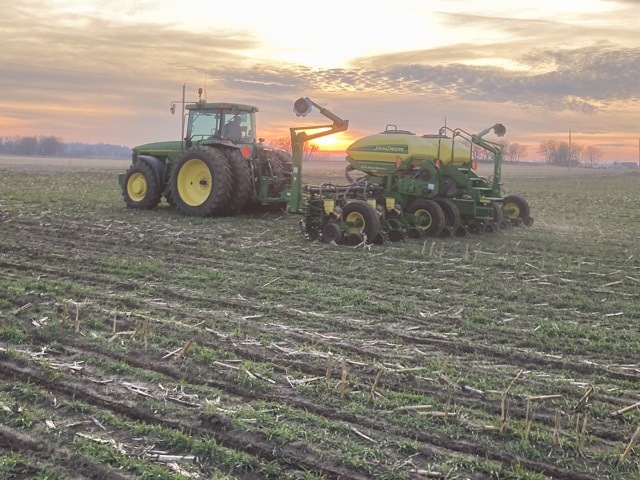Winter Soybeans Test Hardiness
December Soybean Planting Tests Seed Hardiness
ANKENY, Iowa (DTN) -- 'Twas two weeks before Christmas, when all through the shed, Ryan Nell stirred to plant soybeans in a good seedbed.
His planter and tractor were parked with care, when the roar of Nell's diesel filled the air.
While some think it crazy to plant beans in December, 'tis research results the farmer will remember.
TESTING COLD TOLERANCE
"We have no idea what soybeans can really do, what they can handle," said Nell, who is part of a 2,200-acre family farm near Beaver Dam, Wisconsin. The idea is to safely push the limits of early planting, he added, which could increase production and revenue.
A recent multi-state study led by Shawn Conley of the University of Wisconsin indicates soybean yields decrease 0.2 to 0.5 bushels per acre (bpa) per day when seed is planted after April 25. Soybeans planted in mid- to late-April will typically yield 5 to 10 bpa more than mid-May plantings.
"I'm not advocating to plant all soybeans in December, November or March; the risk is too great," Nell said. "But if it's late April and soil and weather conditions are right, get the soybeans in the ground if possible.
"If we can make December-planted soybeans work ... it's taking excuses away, even for us," he added. "It's a confidence booster."
If the soybean seeds overwinter and achieve a "decent" stand, Nell expects them to yield well, possibly in the top 10% of his crop.
"If that happens, it's a victory," he continued.
Conley, a soybean and small grains specialist, routinely conducts early planting and other related research, but nothing to Nell's extreme. He calls Nell's December soybean seeding trial a fun experiment that could yield good data.
"Farmers are innovators and often like to push the envelope to see what works and what doesn't," Conley said. "This is how science is pushed. Someone does something crazy, we learn from it and fine tune it."
MORE BUSHELS
The Nells purchased a strip-till bar and a second planter in 2015 to seed soybeans earlier and boost yields. Nell said in his area, strip-till is necessary to warm and dry the soil faster and to mitigate soil erosion, which can accompany conventional tillage.
P[L1] D[0x0] M[300x250] OOP[F] ADUNIT[] T[]
The decision paid off.
From 2010-14, the Nells' average soybean planting date was May 20-25 and yields averaged about 55 bushels per acre (bpa). From 2015-20, the average planting date was May 13-15 and yields averaged 65 bpa. Last year, commercial soybean planting commenced on April 19.
"We're still missing out on yield potential planting in May," Nell contended.
He has set aside 10 to 15 acres each year since 2018 to conduct early-planting trials in March. He varies seed populations, planting depths and maturity levels to find the right combinations.
Nell initially heard plenty of negative comments from area farmers when he started planting in March in an area not known for warm springs. A few included:
—"It's never going to work."
—"How stupid could you be?"
—"Why would you do that?"
Soybeans planted on March 23, 2018 averaged 77 bpa. "I don't hear the comments anymore," Nell said.
Nell's research, along with university studies, indicate the best time to start planting soybeans is April 20 at 1.75 to 2 inches deep to protect seeds. He's learned he can plant soybeans with a maturity group of 2.4 or higher. Faster-maturing soybeans are typically planted in his area. Nell also learned soil moisture (no sidewall compaction) and temperature (low 40s and rising) need to be right. He admitted planting early comes with risk, such as late frost that can kill young plants.
"It's risk vs reward," Nell said. "We won't lose yield by planting early, but we're giving ourselves the best opportunity for high yields."
DECEMBER EXPERIMENT
The December planting went in late enough to ensure seeds wouldn't germinate. Nell expects emergence in the beginning of May, the same as March plantings.
Nell planted four 30-foot passes of 12 rows each. Treated soybeans were seeded in a strip-tilled field with a cereal rye cover crop. Planting depths were 2.25, 2.5 and 3 inches.
"I feel confident in these soybeans," Nell said. "I did everything possible to give them a chance. Now it's up to Mother Nature. The unknown is whether the seed can sit for that long."
EARLY PLANTING IMPORTANCE
Most soybeans planted in the U.S. are indeterminate varieties and photoperiod sensitive. When plants absorb sunlight longer they have more vegetative growth and flowering during the reproductive period. More flowers equal more nodes, which can mean more pods and more soybeans.
Planting early also allows farmers to plant soybeans with a longer relative maturity, which typically yield more.
"I will tell you, the earlier you plant, the earlier soybeans mature," said Kris Ehler, co-owner of Ehler Brothers Company, a crop input supplier in Thomasboro, Illinois. "That opens up the window for fuller season varieties that may not have been on a grower's radar that carry more yield potential."
Ehler, who also farms, is a proponent of early-planted soybeans and regularly plants when soil conditions allow. He also plants research plots in March or February. Nell considers Ehler his early-planting mentor after discussions at a past Commodity Classic.
"I carry a running average of about a 9 bpa advantage over Mid-May plantings," Ehler said, referring to soybeans planted in late April and earlier.
WINTER'S NAP
Nell plans to share results of his early-planting research, regardless of the outcome.
So with three acres of soybeans settled in for a long winter's nap, this experiment warrants a tip of the cap.
For More Information: www.coolbean.info
Kris Ehler's Facebook page: The Pursuit of 100+ bushel Soybeans
Matthew Wilde can be reached at matt.wilde@dtn.com
Follow him on Twitter @progressivwilde
(c) Copyright 2021 DTN, LLC. All rights reserved.






